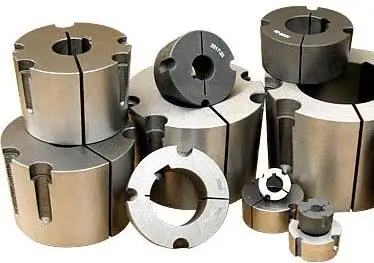china taper bush
Eliminate all screws, oil threads, and the point of the set screws or threads, under the head of the cap screws.
Insert screws into the holes that are threaded on the bushing side, as revealed in Determine two. In measurements where washers are located under the screw head, be sure to use these washers. Please note that there must always be a single screw still left more than that is not used when getting rid of the bushing.
Tighten the screws alternately till the bushing is  loosened in the hub. If the bushing does not loosen immediately, tap on the hub to aid remove.
loosened in the hub. If the bushing does not loosen immediately, tap on the hub to aid remove.
Removing of a Taper Lock bush, like Martin or Fenner Taper Lock bush elements, is as follows:
The Tape r Lock bush requirements to be extensively cleaned, getting rid of all traces of oil, grease, dirt, and metal filings. Cleanse the shaft, the bore, the outside of the bushing, and the bore of the hub in which the bush is to be installed into, making certain the bush is eliminated from the hub, must it currently be mounted.
r Lock bush requirements to be extensively cleaned, getting rid of all traces of oil, grease, dirt, and metal filings. Cleanse the shaft, the bore, the outside of the bushing, and the bore of the hub in which the bush is to be installed into, making certain the bush is eliminated from the hub, must it currently be mounted.
Check the bushing to ensure all surfaces are free of charge from nicks and burrs, and make sure the bushing has no indicators of cracking or exhaustion. Location the bushing into the hub and match fifty percent holes to make full holes. It is critical to be aware that the holes want to be matched, not the threads. Every hole will be threaded on a single facet only.
Oil threads, the position of the established screws or threads, and under the head of the cap screws. Then location the screws loosely into the holes that are threaded on the hub-side, as proven in Determine 1 under.
Make sure that the Taper Lock bush is cost-free in the hub, then slip the assembly on to the shaft and locate in the wanted position. Insert the accurately sized essential into the shaft keyway, ensuring the important is a push fit into the shaft keyway. Guarantee there is an air hole in between the leading of the essential and the bushing keyway slot. This will avert cracking of the bush. Crucial: Guarantee that there is no oil or lubricant between the taper on the outside of the bushing and the taper bore of the hub, to which the bushing is being put in.
Screws need to be tightened alternately and evenly right up until all screws are pulled up and the bushing is sq. into the hub.
Employing a hammer and block, or sleeve, towards the big stop of the Taper Lock bush will help to steer clear of harm to the bushing. Flippantly faucet from the busing to make certain it is seated squarely. The screws are then tightened further. A torque wrench is utilized to tighten the screws alternatively and evenly till they are all to the recommended torque placing. This details is available from the set up sheet that accompanies any new Taper Lock bush. See illustration chart below (determine three), or question for this info at any CBC workplace.
Repeat this alternate hammering and screw tightening right up until the specified torque is achieved and no lengthier calls for tightening following hammering. Critical: Following a period of time of running beneath standard situations, it is suggested that the software be reviewed to ensure the torque configurations of the screws are accurate, and do not need re-tightening.
Fill the holes that are not used with grease or silicone sealant to stop them from filling with filth and/or rust.
Obtain up to day with recent info about china taper bush at our helpful website.